扩展功能
文章信息
- 马栋, 付重滔, 李磊
- MA Dong, FU Chong-tao, LI Lei
- 莲花山隧道进口回填冲沟段加固技术
- Reinforcement Technology of Backfill Gully at Entrance of Lianhuashan Tunnel
- 公路交通科技, 2021, 38(6): 17-22
- Journal of Highway and Transportation Research and Denelopment, 2021, 38(6): 17-22
- 10.3969/j.issn.1002-0268.2021.06.003
-
文章历史
- 收稿日期: 2020-11-17
2. 中铁十六局集团第一工程有限公司, 北京 101300;
3. 交通运输部公路科学研究所, 北京 100088
2. 1st Engineering Co., Ltd. of China Railway 16 th Bureau Group Co., Ltd., Beijing 101300, China;
3. Research Institute of Highway, Ministry of Transport, Beijing 100088, China
复杂地质环境隧道的出入口施工常遇到浅埋偏压小净距情况,隧道施工时两隧道间围岩有向浅埋侧位移的趋势,支护结构受力分布不对称,围岩的应力状态(特别是中夹岩)和支护结构的受力状态均会受到相邻洞室开挖的影响而恶化,隧道稳定性较差[1-5]。针对浅埋偏压小净距隧道的进洞施工问题,国内外学者已在隧道进洞开挖顺序、施工工法设计参数、支护技术措施等方面形成了较多的工程应用技术成果[6-13],在隧道洞口滑坡整治措施方面积累了一定的工程经验[14-17]。但由于隧道工程地质条件的不确定性,复杂地质条件隧道的施工方案仍需经过研究确定。
莲花山隧道进口K1+280~K1+480段需通过建筑弃渣回填的天然冲沟,该段为浅埋偏压小净距隧道,且隧道进洞施工时正值当地雨季,极易发生失稳现象[18]。因此,为保证莲花山隧道施工安全,提出了在隧道进口段采用支护桩加固中夹岩(小净距隧道双洞间岩体)的方案,并建立数值模型分析该方案对隧道变形的控制作用,最终通过在进口段施工过程监测仰坡变形验证方案的应用效果。
1 工程概况莲花山隧道为一座双向六车道分离式隧道,采用三心圆形式,开挖跨度17.5 m、高度11.9 m,属超大断面隧道。隧道进口位于里程K1+280,平面布置为小净距,进洞口段为莲花山西麓稳定缓坡,坡度约10°~50°,覆盖层为红黏土,硬塑状,下伏基岩钻探揭露为石炭系上统马平组(C3 m)微风化灰岩。隧道K1+280至冲沟止点K1+480段于2014—2015年进行了建筑弃渣的回填,导致原自然地面发生变化,回填后线路范围内地面标高为146.00~170.00 m,其中K1+400~K1+480冲沟段地面标高为152.00~155.50 m,K1+280回填前后横断面如图 1所示。该段隧道埋深为17.00~33.00 m。围岩级别为Ⅴ级,采用复合衬砌型式,初期支护采用4.0 m 22药卷锚杆、I22B型钢钢架@50 cm、29 cm厚C20喷射混凝土,二次衬砌采用70 cm厚C30钢筋混凝土拱墙。
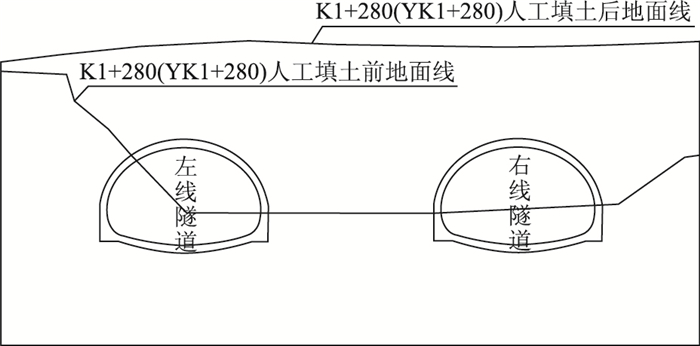
|
| 图 1 K1+280地质横断面 Fig. 1 Geological cross-section K1+280 |
| |
2 加固方案分析 2.1 加固方案
针对莲花山隧道进口段的埋深浅、偏压、小净距特点,并结合以往工程实践经验,原设计拟采用右洞(埋深较浅侧)先开挖、左洞(埋深较深侧)后开挖的顺序控制隧道的侧向位移。但在现场施工时发现隧道右洞地层为微风化灰岩、左洞地层为硬塑红黏土,并且周边环境复杂,不具备炸药爆破条件,只能采用静态爆破配合机械破除,右洞先行开挖的话将严重影响工期。综合现场实际情况,参建各方最终决定隧道进洞施工采用先左后右(先软后硬)的顺序。同时考虑到莲花山隧道洞口红黏土扰动后的自稳定性很差且施工正值柳州市多雨季节,连续强降雨作用下红黏土将明显地软化,隧道施工极有可能引发大规模工程滑体灾害。因此,隧道施工方提出拟在进口段中夹岩加设钢筋混凝土支护桩的措施以控制隧道变形。支护桩设计参数如下:
(1) 共43根1.20 m直径的钢筋混凝土支护桩,YK1+327~YK1+387段桩间距3.0 m,YK1+387~YK1+439段桩间距4.0 m,YK1+439~YK1+466段桩间距3.0 m,各桩位具体位置如图 2所示。
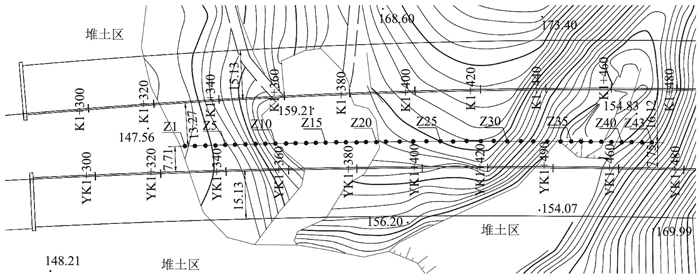
|
| 图 2 支护桩平面布置(单位:m) Fig. 2 Plane layout of support piles(unit: m) |
| |
(2) 桩端入隧道仰拱以下不小于3.0 m,具体桩长及桩顶、底标高如图 3所示。

|
| 图 3 支护桩纵断面布置(单位:m) Fig. 3 Profile layout of support piles(unit: m) |
| |
(3) 桩身采用C30混凝土,钢筋采用HRB400钢筋。桩顶设置钢筋混凝土帽梁,b×h=120 cm×70 cm,帽梁长度根据支护桩的布置段落确定。
2.2 加固效果数值分析为论证在隧道进口段中夹岩加设钢筋混凝土支护桩措施对隧道变形的控制效果,选取进口段典型断面K1+420建立平面应变弹塑性模型(如图 4所示),对比分析无降水条件下隧道加设钢筋混凝土支护桩前后隧道的变形情况。
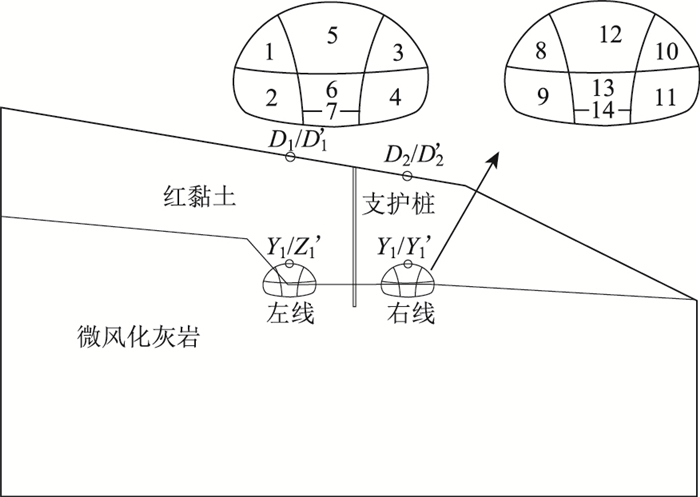
|
| 图 4 K1+420地质横断面 Fig. 4 Geological cross-section K1+420 |
| |
隧道施工过程模拟仅考虑初期支护,初期支护在各部分开挖后紧跟施作。计算结果分析选取左、右线中导洞拱顶监测点(Z1,Y1)、地表监测点(D1,D2)的水平位移和竖向位移(有支护桩时左右线中导洞拱顶监测点分别为Z′1,Y′1,地表监测点分别为D′1,D′2),监测点的位移计算结果不包括模型初始地应力平衡时发生的变形量。隧道施工工法采用双侧壁导坑法,导洞开挖顺序如图 4所示(其中施工步7和14为拆除临时支撑),此处不再赘述。
采用有限元软件建立平面应变模型,隧道左线埋深32.5 m、右线埋深26.5 m,左右线隧道间距36 m。隧道外轮廓线与模型两侧边界距离为80 m,与底部边界距离为60 m。模型中围岩采用平面单元、M-C本构模型模拟,初期支护与支护桩采用梁单元、弹性本构模型模拟。模型上边界为自由面,其他边界约束法向位移,计算模型如图 5所示。
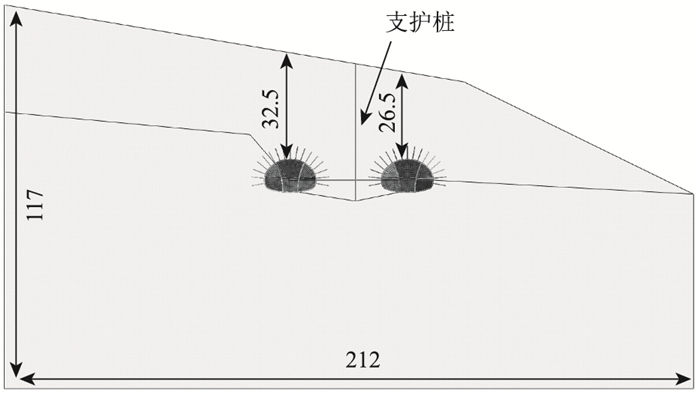
|
| 图 5 模型网格(单位:m) Fig. 5 Model grid(unit: m) |
| |
计算模型中初期支护的型钢钢架和喷射混凝土、支护桩的钢筋混凝土桩和桩间土均按照等刚度原则(EA=EdAc+EsAs)等效为整体。根据莲花山隧道工程地质勘察报告及公路隧道设计规范相关建议参数,数值模型中围岩与支护结构计算参数取值见表 1。
| 材料名称 | 弹性模量/GPa | 泊松比 | 密度/(kg·m-3) | 黏聚力/kPa | 内摩擦角/(°) |
| 红黏土 | 0.2 | 0.4 | 1 720 | 32.5 | 14 |
| 微风化灰岩 | 4.0 | 0.35 | 2 450 | 400 | 32 |
| 初期支护 | 25 | 0.3 | 2 500 | — | — |
| 支护桩 | 26 | 0.3 | 2 500 | — | — |
| 锚杆 | 210 | 0.3 | 7 850 | — | — |
2.3 计算结果分析
(1) 隧道拱顶测点位移
加设支护桩前后,隧道拱顶测点竖向位移与水平位移随隧道掘进的变化规律如图 6、图 7所示。
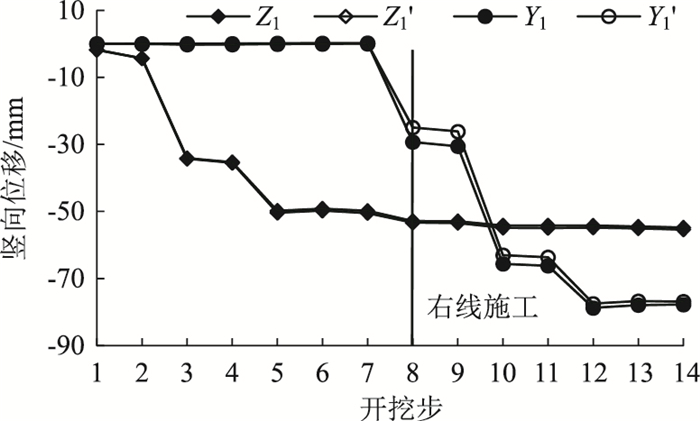
|
| 图 6 隧道拱顶测点竖向位移变化曲线 Fig. 6 Curve of vault vertical displacement change |
| |
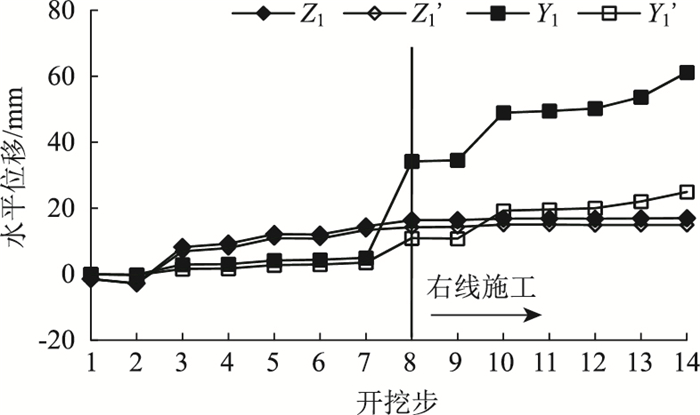
|
| 图 7 隧道拱顶测点水平位移变化曲线 Fig. 7 Curves of tunnel vault horizontal displacement |
| |
① 加设支护桩前后,隧道拱顶测点沉降值较接近、变化规律基本相同。其中,Z′1测点沉降值略小于Z1测点,Z′1和Z1测点沉降最大值分别为54.8,55.4 mm;Y′1测点沉降值略小于Y1测点,Y′1和Y1测点沉降最大值分别为76.9,77.8 mm。
② 加设支护桩前后,左线隧道拱顶测点水平位移值及其变化规律差别不大,右线隧道拱顶测点水平位移变化规律基本相同,但Y′1测点水平位移值明显小于Y1测点。其中,Z′1测点水平位移值略小于Z1测点,Z′1和Z1测点水平位移最大值分别为14.9,16.9 mm;Y′1测点水平位移值明显小于Y1测点,Y′1和Y1测点沉降最大值分别为24.9,61.2 mm。
(2) 地表测点位移
加设支护桩前后,地表测点竖向位移与水平位移随隧道掘进的变化规律如图 8、图 9所示。
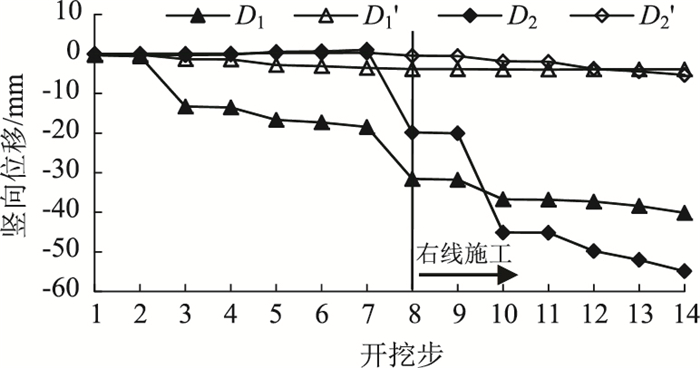
|
| 图 8 地表测点竖向位移变化曲线 Fig. 8 Curves of vertical displacement at surface measurement points |
| |
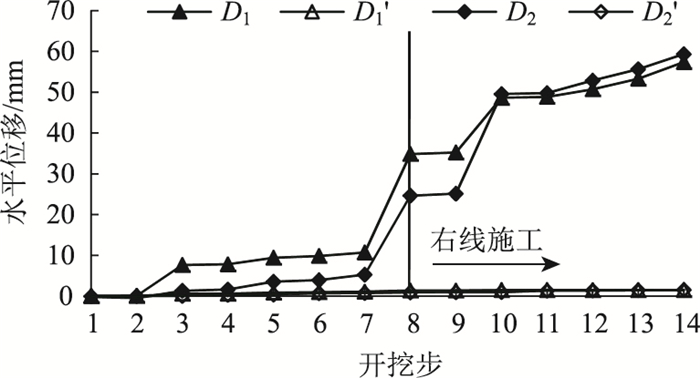
|
| 图 9 地表测点水平位移变化曲线 Fig. 9 Curves of horizontal displacement at surface measurement points |
| |
① 未加设支护桩时,右线隧道开挖造成地表测点D1与D2的沉降和水平位移值明显增大,而加设支护桩后地表测点位移变化很小。以D2点为例,左线隧道开挖完毕(开挖步7)时D2沉降值和水平位移值分别为0.3,5.3 mm,右线隧道开挖时(开挖步8)D2沉降值和水平位移值分别为19.8, 24.6 mm。
② 加设支护桩后地表测点沉降值明显减小。其中,未加设支护桩时,D1和D2测点沉降最大值分别为40.1,54.9 mm;加设支护桩后,D′1和D′2测点沉降最大值分别为3.9,5.3 mm。
③ 加设支护桩后地表测点水平位移值明显减小。其中,未加设支护桩时,D1和D2测点水平位移最大值分别为57.4,59.3 mm;加设支护桩后,D′1和D′2测点沉降最大值分别为1.5,1.7 mm。
综上所述,加设支护桩对隧道水平位移和地表位移的控制效果显著。其中,未采用支护桩措施时,右线隧道(后行、浅埋侧)的整体水平位移明显大于左线隧道,达到61.2 mm,并且地表测点水平位移最大值为59.3 mm、沉降最大值为54.9 mm;采用支护桩措施后右线隧道整体水平位移减小为24.9 mm,地表测点水平位移最大值为1.7 mm、沉降最大值为5.3 mm。因此,考虑到工程所在地的多雨天气,雨水软化作用将加剧隧道侧向变形,可认为在莲花山隧道进口段中夹岩打设支护桩进行加固是极有必要的。
3 现场地表沉降监测莲花山隧道项目部2017年2月20日开始支护桩施工,施工工序主要有测量放样→埋设护筒→旋挖钻施工→清孔→下钢筋笼→混凝土灌桩→帽梁施工等,成孔与浇注从小里程往大里程进行,并于2017年4月30日完成了全部支护桩的浇注工作。2017年5月8日,隧道开始进洞施工,同时通过监测左线隧道进口洞顶仰坡地表沉降(监测断面对应洞内断面里程K1+320,以隧道中线向两侧共布置6个监测点,监测点横向间距为6 m。)以判断加设支护桩后仰坡的稳定性,施工期间的地表测点沉降时态曲线如图 10所示。
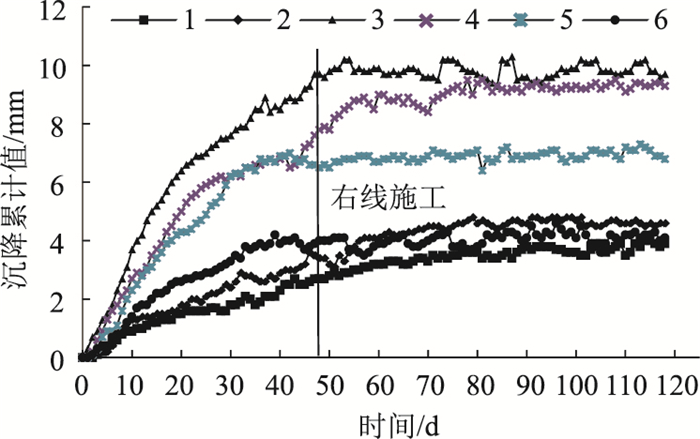
|
| 图 10 地表测点沉降时态曲线 Fig. 10 Temporal curves of settlement at surface measurement points |
| |
由图 10看出:
(1) 左线隧道进口仰坡的沉降量较小,处于稳定状态。其中,3号测点的沉降值最大,约10.2 mm;其次为4号测点约9.5 mm,其他测点的沉降最大值为3.9~4.7 mm。
(2) 仰坡地表各测点沉降变形在左线施工30~50 d后趋于稳定,进口右线隧道施工对左线仰坡变形影响很小。
4 结论目前,莲花山隧道已顺利通过进口回填冲沟区段(K1+280~K1+480),施工期间多次出现连续数天降大暴雨天气,左线隧道进口仰坡地表沉降测点4个月的最大沉降值为10.2 mm,洞内初期支护与二次衬砌结构均未出现病害现象,说明采用支护桩加固中夹岩有效控制了隧道开挖扰动和降雨软化等共同作用下的围岩变形。
| [1] |
杨小礼, 眭志荣. 浅埋小净距偏压隧道施工工序的数值分析[J]. 中南大学学报: 自然科学版, 2007, 38(4): 764-770. YANG Xiao-li, SUI Zhi-rong. Numerical Simulation of Construction Sequence for Shallow Embedded Bias Tunnels with Small Clear Distance[J]. Journal of Central South University: Science and Technology Edition, 2007, 38(4): 764-770. |
| [2] |
吴德兴, 李伟平, 谢宝超, 等. 陡坡偏压小净距隧道施工扰动空间效应研究[J]. 铁道科学与工程学报, 2016, 13(5): 906-913. WU De-xing, LI Wei-ping, XIE Bao-chao, et al. Study on Construction Disturbance Spatial Effect of Bias Tunnels with Small Interval and Steep Slope[J]. Journal of Railway Science and Engineering, 2016, 13(5): 906-913. |
| [3] |
杨灵. 小净距隧道施工力学效应研究[D]. 北京: 中国矿业大学, 2014. YANG Ling. Study on Construction Mechanics Effect of Shallow-buried Bias Tunnels with Small Interval[D]. Beijing: China University of Mining and Technology, 2014. |
| [4] |
彭从文, 朱向荣, 王金昌. 基于三维有限元模型的小净距隧道施工力学分析[J]. 公路交通科技, 2008, 25(12): 138-145. PENG Cong-wen, ZHU Xiang-rong, WANG Jin-chang. Mechanical Analysis of Small Interval Tunnel Based on Three-dimensional FEM Model[J]. Journal of Highway and Transportation Research and Development, 2008, 25(12): 138-145. |
| [5] |
袁维, 傅鹤林, 徐武, 等. 偏压隧道的进洞施工扰动效应及安全监控[J]. 铁道科学与工程学报, 2012(5): 65-70. YUAN Wei, FU He-lin, XU Wu, et al. Disturbance Effect of Unsymmetrical Pressure Tunnel's Entrance Construction and Safety Monitoring[J]. Journal of Railway Science and Engineering, 2012(5): 65-70. |
| [6] |
靳晓光, 刘伟, 郑学贵, 等. 小净距偏压公路隧道开挖顺序优化[J]. 公路交通科技, 2005, 22(8): 61-64. JIN Xiao-guang, LIU Wei, ZHENG Xue-gui, et al. Optimization of Excavating Sequence for Closely Spaced Bias Doubletube Tunnels[J]. Journal of Highway and Transportation Research and Development, 2005, 22(8): 61-64. |
| [7] |
刘小军, 张永兴. 浅埋偏压隧道洞口段合理开挖工序及受力特征分析[J]. 力学与工程学报, 2011(增1): 3066-3073. LIU Xiao-jun, ZHANG Yong-xing. Analysis of Reasonable Excavation Sequence and Stress Characteristics of Portal Section of Shallow Tunnel with Unsymmetrical Loadings[J]. Chinese Journal of Rock Mechanics and Engineering, 2011(S1): 3066-3073. |
| [8] |
王更峰, 熊晓晖, 张永兴. 大跨小净距隧道合理开挖方法与支护参数对比研究[J]. 交通科技, 2011, 28(3): 101-107. WANG Geng-feng, XIONG Xiao-hui, ZHANG Yong-xing. Comparative Study of Rational Excavation Method and Support Parameter for Large-span Small-spacing Tunnel[J]. Journal of Highway and Transportation Research and Development, 2011, 28(3): 101-107. |
| [9] |
赵永国, 邵生俊, 韩常领. 浅埋偏压隧道开挖施工方案的仿真分析[J]. 岩土力学, 2009, 30(2): 510-513. ZHAO Yong-guo, SHAO Sheng-jun, HAN Chang-ling. Simulation on Different Excavation Construction of the Shallow-buried Tunnel under the Uneven Rock Pressure[J]. Rock and Soil Mechanics, 2009, 30(2): 510-513. |
| [10] |
侯瑞彬, 申玉生, 陈明奎. 大跨小净距偏压隧道施工方案优化分析[J]. 公路, 2014(4): 225-230. HOU Rui-bin, SHEN Yu-sheng, CHEN Ming-kui. Analysis of Construction Schemes Optimization for Large-span Bias Tunnels with Small Clear Distance[J]. Highway, 2014(4): 225-230. |
| [11] |
王怡, 王芝银, 李云鹏. 偏压作用下小间距隧道的施工方法研究[J]. 现代隧道技术, 2008(3): 29-35. WANG Yi, WANG Zhi-yin, LI Yun-peng. Study on the Construction of Uneven-pressured Twin Tunnels with Small Spacing[J]. Modern Tunnelling Technology, 2008(3): 29-35. |
| [12] |
舒志乐, 刘保县, 黄山, 等. 大跨偏压小净距隧道分部导坑法施工力学效应[J]. 地下空间与工程学报, 2016, 12(6): 1623-1630. SHU Zhi-le, LIU Bao-xian, HUANG Shan, et al. Study on Construction Mechanical Effect of Division Pilot Method in Large Span Tunnel with Small Interval of Bias[J]. Chinese Journal of Underground Space and Engineering, 2016, 12(6): 1623-1630. |
| [13] |
王薇, 邹江海, 潘文硕, 等. 不同施工顺序对陡坡偏压小净距隧道围岩稳定性的影响研究[J]. 中国安全生产科学技术, 2016, 12(8): 28-33. WANG Wei, ZOU Jiang-hai, PAN Wen-shuo, et al. Study on Influence to Stability of Surrounding Rock by Different Construction Sequence for Bias Tunnel with Small Interval and Steep Slope[J]. Journal of Safety Science and Technology, 2016, 12(8): 28-33. |
| [14] |
黄懿, 张文瀚, 陈绪刚, 等. 基于蠕变效应的浅埋偏压软岩隧道受相邻隧道开挖的影响分析[J]. 现代隧道技术, 2020, 57(增1): 425-432. HUANG Yi, ZHANG Wen-han, CHEN Xu-gang, et al. Analysis of Effect on Shallow Buried Bias Tunnel in Soft Rock Induced by Adjacent Tunnel Excavation Based on Creep Mechanism[J]. Modern Tunnelling Technology, 2020, 57(S1): 425-432. |
| [15] |
李世琦, 徐升, 唐锐, 等. 顺层岩质边坡隧道洞口挤压变形处治技术研究[J]. 地下空间与工程学报, 2020, 16(增1): 480-485. LI Shi-qi, XU Sheng, TANG Rui, et al. Research on Treatment Technology of Tunnel Portal Extrusion Deformation in Bedding Rock Slope[J]. Chinese Journal of Underground Space and Engineering, 2020, 16(S1): 480-485. |
| [16] |
张可能, 李斌, 张洪亮, 等. 某隧道洞口段斜穿复合型滑坡体的综合治理及评价[J]. 公路交通科技, 2020, 37(5): 100-107. ZHANG Ke-neng, LI Bin, ZHANG Hong-liang, et al. Comprehensive Treatment and Evaluation of Inclined Composite Landslide in Portal Section of a Tunnel[J]. Journal of Highway and Transportation Research and Development, 2020, 37(5): 100-107. |
| [17] |
黄冠涛. 抗滑桩与钢管桩在分离式隧道洞口滑坡治理中的应用[J]. 施工技术, 2018, 47(18): 88-91. HUANG Guan-tao. Application of Anti-slide Pile and Steel Pipe Pile in the Landslide Control of the Separated Tunnel Hole[J]. Construction Technology, 2018, 47(18): 88-91. |
| [18] |
朱苦竹, 王阳. 降雨对小净距大跨度隧道开挖松动区的影响[J]. 铁道建筑, 2017(4): 64-67. ZHU Ku-zhu, WANG Yang. Influence of Rainfall on Excavation Loosened Zone of Large-span Tunnel with Small Spacing[J]. Railway Engineering, 2017(4): 64-67. |
 2021, Vol. 38
2021, Vol. 38
